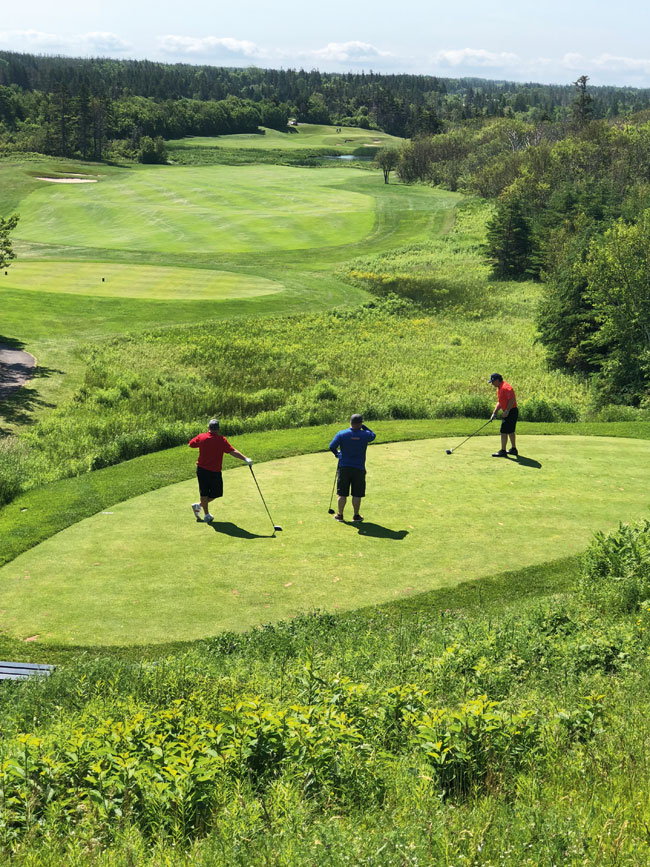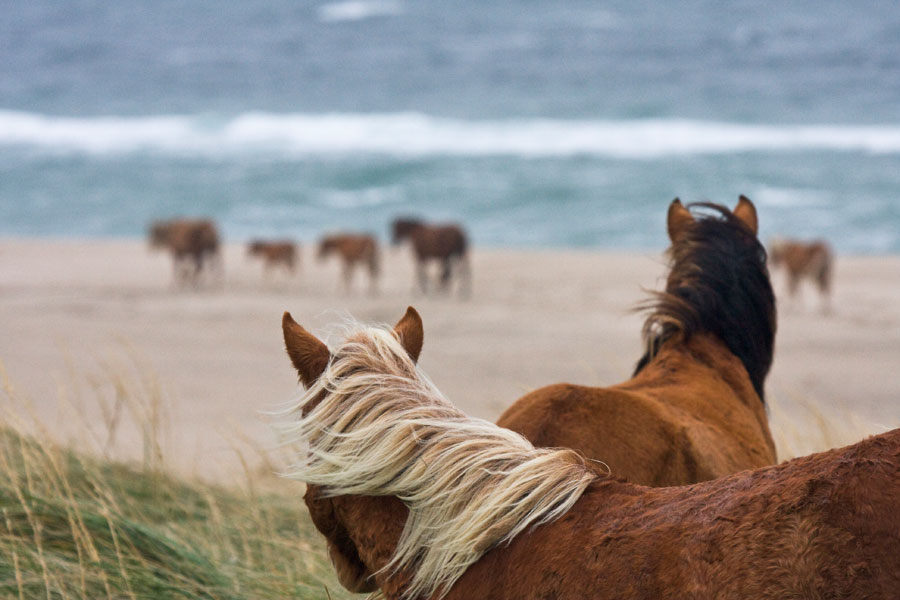Here, cruising for eagles and birdies (and birds!) on a surf and turf Maritime expedition.
Splashing water, sideways winds and deep sand could cloud a duffer’s expectations of playing the fairways, but these are the stuff of dreams for my fellow ardent golfers huddled alongside me in the zodiac. Bouncing across waves, the cheek-slapping wind merely boosted our excitement as we veered toward land, eager to disembark on the sandy beach for another round in Canada’s celebrated world of maritime golf.
By this, the fifth day of a week-long golf itinerary with One Ocean Expeditions, we had honed our expedition cruising routine. With our ship anchored in the Gulf of the St. Lawrence, we were skilled at donning wet gear and PFDs (personal flotation devices), descending the gangplank into a zodiac, zipping ashore to a dry pier, doffing our wet gear, then shuttling to a golf course. This day was unique, however, and thrilling beyond imagination. We forged a “wet-landing” on to the dune-fringed beach right at the sea-level entry to The Links at Crowbush Cove and, minutes later, arrived at the clubhouse. Playing through this gem of Prince Edward Island’s golf scene — marked by challenging emerald fairways, carries over water and grassy dunes — the elevated tees and greens provide vast views of the coastline, our zodiacs bobbing shoreside and, our ship, the Akademik Ioffe, gleaming white on the horizon.
When One Ocean Expeditions (OOE) announced that — between its Antarctic and Arctic seasons — the icebreaker ocean research vessel Akademik Ioffe would sail an inaugural Fiddles and Sticks golf itinerary, including Cape Breton’s Cabot Cliffs and Cabot Links, Highland Links and P.E.I.’s The Links at Crowbush Cove, I was hooked by the idea of playing Canada’s maritime beauties within a week without driving distances between them. The rare chance to visit remote Sable Island added allure.
Embarking the voyage at Louisbourg Harbour after a morning tour of historic Fortress of Louisbourg, it was evident that OOE’s team had refined complex logistics to combine expedition cruising with golf and local culture. As the crew cinched our PFDs for the first zodiac shuttle out to the ship, we were greeted by Celtic music from a kilted bagpiper and the ship’s two resident musicians, one playing a fiddle, the other a mandolin.

That evening, we dined on lobster, and program co-ordinator Ian Peck outlined the next day’s plans for arrival in Inverness, Cape Breton. “This is Plan A,” he said, “but this is expedition cruising, and things can change.” Non-golfers had options to tour Baddeck, visit the Alexander Graham Bell museum and go cycling or hiking with the ship’s naturalist guide.
Early next morning, we arrived at Cabot Links, ranked 43rd in Golf Digest’s World 100 Greatest Golf Courses, to see the crew unwrapping golfers’ clubs from protective “dry bags.” Though Cabot Links’ rickshaws are light to manoeuvre along long, rolling fairways, I felt smart to have booked a caddie to pull my clubs and guide my shots. A true links course skimming the water line, it is reminiscent of Scotland’s courses, demanding long carries over scrub, accuracy to avoid bunkers chiselled around greens, and a good eye for wavy greens. As I strode excitedly to my drive from the 11th forward tee, my golf mate — an Englishman who drove from the black markers – said, “Yeah, this is a gorgeous links environment, but these fairways are wider, more forgiving than the U.K.’s narrow links.”
Later, when all passengers mingled ashore for whisky tasting and Celtic dinner at Glenora Distillery, it was announced that the ship’s biologist Matt had scored the men’s longest drive at 400 yards and eagled the 11th.
Bleak skies and brisk breezes did not dampen our exhilaration for Cabot Cliffs, ranked ninth in the World 100 Greatest Golf Courses. Stunning views unfolded as I followed the lush fairways uphill over rolling topography to reach the crest of a jagged cliff facing spectacular, daunting fairways. On the 16th par-3, my caddie’s tip made my day. He said, “Hit left, and your ball will roll right to the pin.” A birdie would have been nice, but I loved the “ping” sound of my par putt. By the round’s end, the sky was clear and breeze light. Back on board, when people shouted, “Whales!” I raced to the stern just in time to see a tail flip and disappear under water.
That evening, the ship navigated toward Magdalen Islands, an archipelago in the St. Lawrence where Quebec and Maritime cultures mingle. Expedition leader Kaylan outlined options including a zodiac tour of the red stone cliffs, kayaking, paddle-boarding, cycling and a bus tour of La Grave, including historic, cultural and culinary delights.

The sky was clear blue, waters calm as the zodiacs beached La Grave harbour, and passengers joined various groups. In a zodiac with massage therapist Annie at the helm, my group cruised along the escarpment in a slow tour along the cliffs toward a distant, rugged promontory thriving with sea birds. Besides seeing huge great black cormorants and Northern gannets diving for fish, we were mesmerized by how hundreds of birds had colonized in what I can best describe as a cliffside condo for birds. Tucked into every crevice of the vertical stone was a bird or clusters of birds guarding a nest, some with fluffy chicks.
As Annie silenced the motor, we revelled in the sounds of nature, the birds’ songs, the lapping waves. Looking up, we spotted a fox peering down from the cliff top, likely scheming for a kill.
When we gathered on the ship’s deck for a feast of oysters fresh from the sea, ornithologist Christopher identified our bird pictures as species of great black-backed gulls, herring gulls and black-legged kittiwake.
After the beach departure from P.E.I.’s The Links at Crowbush Cove — where non-golfers had hiked the parabolic dunes of Greenwich National Park — we sailed to Ingonish, Cape Breton, for a final round at Highland Links. Built in 1941, this globally famed hallmark of genius golf course architect Stanley Thompson ambles through dynamically shifting topography and elevations, giving scenic views of sea and forested mountains. Compared to the previous, fairly manicured courses, this classic course appeared rustic, though a brilliant test of golfing skills.
Back on board, reminiscing over highlights, my tablemates’ chatter turned to future golf dreams. It turns out that next year, One Ocean Expeditions is inaugurating a golf cruise to the top links in Scotland and Ireland on its new RCGS Resolute, a larger ship, specifically designed for tourism.
Arriving by sea makes sense. Cruising to play had put my game and appreciation of Canada’s maritime nature to the fore. For the love of golf, I thought, why not cruise to the birthplace of the game? I’ve already booked my caddy.
If You Go
Do
Take the Sable Island excursion. The last day at sea proved a true expedition as the Akademik Ioffe anchored in the Atlantic Ocean about 300 kilometres southeast of Halifax. Scooting in zodiacs across whitecaps, past dozens of curious seals bobbing in the waves, we landed on the island’s sandy beach. Really a 42 kilometre-long sandbar, Sable Island is Canada’s newest National Park, inhabited only by wild horses, seals, migratory birds and a small group of scientists manning a station. Following a Parks Canada guide, I felt privileged to explore this pristine patch of the world.
